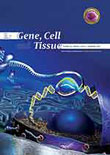فهرست مطالب

Gene, Cell and Tissue
Volume:2 Issue: 3, Jul 2015
- تاریخ انتشار: 1394/06/18
- تعداد عناوین: 5
-
-
Page 1Context: Cancer is a major cause of death worldwide. It was estimated that 7.6 million people died during 2008 due to cancer and this figure is expected to double by 2030. To conquer this disease, discovery of validated targets and new drugs is a necessity..Evidence Acquisition: Telomeres are terminal structures of linear chromosomes in eukaryotes and consist of multiple repetitive sequences. Their main function is to protect and confer stability to chromosome ends and prevent their breakage, end-to-end fusion, and degeneration. Polymerases responsible for replication of DNA in eukaryotes are not able to replicate chromosome ends and, during cell division, chromosomes continuously become shorter from the telomere ends. This shortening will eventually stop cell division. In cancer cells, there is a ribonucleoprotein enzyme called telomerase that allows compensation of telomere shortening and continuation of the cell multiplication process..ResultsAbout 90% of cancers need a high level of this enzyme to continue cell multiplication. Since this enzyme set is absent in normal cells, or present at a very low level, use of telomerase inhibitors cannot have significant effects on normal cells..ConclusionsSince telomerase is expressed in 90% of cancer cells, its inhibition can be considered as a goal of cancer treatment..Keywords: Telomere, Telomerase, Cancer
-
Page 2BackgroundChronic idiopathic thrombocytopenic purpura (CITP) is an autoimmune disease with low platelet count and potentially bleeding tendency. Although autoimmune mechanisms play a crucial role in the disease yet in 20% of cases underlying diseases such as Helicobacter pylori (HP) infection can be involved..ObjectivesThe aim of this study was to evaluate effects of H. pylori eradication therapy on platelet count in CITP patients with H. pylori infection..Patients andMethodsDuring this clinical trial, performed from September 2011 to August 2012, twenty-three patients with CITP were divided in two groups, including one group with H. pylori infection and the other without infection. After determination of baseline platelet count in the two groups, patients with H. pylori infection underwent eradication therapy. Both groups were followed up for six months and platelet counts were checked at one-month intervals and finally, changes in platelet counts were statistically compared before and after treatment and also between the two groups..ResultsFrom a total of 23 patients with CITP, 43% (10) of the cases were H. pylori positive and after eradication therapy, eight patients (80%) were successfully treated. Helicobacter pylori eradication therapy causes a statistically significant difference between the mean platelet count before and after HP eradication therapy..ConclusionsHelicobacter pylori infection has a significant effect on platelet count in patients with CITP and H. pylori eradication therapy should be considered as an important factor in platelet count recovery in CITP patients..Keywords: Blood Platelets, Thrombocytopenia, Helicobacter pylori
-
Page 4BackgroundUrtica dioica L. (stinging nettle) has been accepted for decreasing blood glucose levels; however, the exact mechanism of its anti-hyperglycemic effect remains to be understood..ObjectivesWe aimed to examine the effects of ethanolic extract of stinging nettle leaves on blood glucose levels and gene expression of Glucose Transporter 2 (Glut2) in liver of alloxan-induced diabetic mice..Materials And MethodsTwenty-four male Naval medical research institute (NMRI) mice were randomly divided to three groups. The control group received saline (10 mL/kg, intraperitoneally) for eight days, the diabetic group received three days of injections of alloxan (200 mg/kg, intraperitoneally) followed by five days of injections of ethanol (20%), and the diabetic + nettle extract group received alloxan for three days followed by five days of injections of the nettle extract (150 mg/kg). Mice were weighed before and after treatments (on days one and nine). On day nine, mice were sacrificed, blood samples were collected for measuring glucose levels and liver was dissected to examine changes in the Glut2 gene expression with the semi-quantitative reverse-transcription-polymerase chain reaction (RT-PCR) method..ResultsThe results showed that the nettle extract significantly decreased high levels of blood glucose (P < 0.001). The nettle extract also had a preventive effect on decrease in body weight. In addition, the results showed that the Glut2 gene expression was increased in liver of diabetic mice (P < 0.05) and was significantly prevented by the nettle extract in diabetic + nettle extract group (P < 0.05)..ConclusionsIt can be concluded that the nettle extract can reduce blood glucose levels in diabetic mice, at least partly, by influencing the Glut2 gene expression in mice liver..Keywords: Diabetes Mellitus, Gene Expression, Glucose Transporter Type 2, Urtica dioica
-
Page 5BackgroundThe recent years has seen enormous research attempts in the study for genetic factors that may predispose individuals to periodontitis, as one of the most common chronic infectious disease in humans..ObjectivesThe aim of the present study was to determine the breakdown of interdental gingiva tissues in chronic periodontitis patients with TGF-β1 (-509) C/T polymorphisms..Patients andMethodsA total of 60 gingival samples, including 45 patient and 15 healthy subjects, were selected for this study. Following determination of TGF-β1 (-509) C/T gene polymorphism by Tetra primer amplification refractory mutation system-polymerase chain reaction (T-ARMS-PCR), the patients were divided to three subgroups according to their genotype (6 TT, 21 TC and 18 CC). After tissue processing, sectioning and staining, quantitative parameters were estimated by Cavalieri’s point-counting estimation..ResultsThe Volume density (Vʋ) of epithelium, connective tissue, collagenous and non-collagenous matrix and blood vessels had statistically significant differences between the control and chronic periodontitis (CP) groups (P < 0.0001). Statistically significant differences in the Vʋ of collagenous matrix, non-collagenous compartment and blood vessels between TT, TC and CC groups were found (P < 0.0001). There were no statistically significant differences in the Vʋ of epithelium, connective tissue of gingiva and non-collagenous matrix between TT, TC and CC groups (P > 0.05)..ConclusionsThe results of the present study showed that TGF-β1 (-509) C/T is strongly associated with quantitative parameters of connective tissue constituents of interdental papilla in CP patients..Keywords: Chronic Periodontitis, Genes, Gingiva, Histology, Polymorphism, Transforming Growth Factor Beta, Genetic

